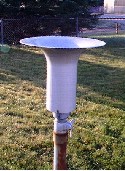 |
Snowfall is measured in several different ways.
The nipher snow gauge is used to capture snow and measure
its water content in millimetres. It's much bigger than either the
standard rain gauge or the tipping bucket. The nipher snow
gauge is mounted on a sliding metal pipe so that, as snow
accumulates over the winter, the whole gauge can be raised to keep the top edge 5 feet above the surface of the snow.
Why? So that snow from the ground doesn't drift into the
gauge and give us false readings! |